Tankless water heaters help new laundromat owner enjoy energy savings.
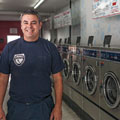
Why would a 20-year plumbing industry veteran with a thriving business that already absorbs nearly all his waking hours suddenly decide to try his hand at running a laundromat?
“I’m just not comfortable having all my eggs in one basket,” explains J.R. Nunez, owner of Imperial Highway Plumbing, Heating & Air in Brea, Calif., and Lambert Laundry in nearby Whittier. “When the economy began to slow a couple of years ago, I began exploring new ventures. I had worked on a few laundromat renovations over the years, so I figured now might be a good time to own one myself.”
Thus, in May 2011 Nunez became the proud owner of what he describes as the “worst-looking laundromat in town.” His first move was to shutter the place for 90 days and commence extensive renovations.
Now, you might expect one of the first projects Nunez would tackle would be to upgrade the facility’s aging, low-performing hot-water system: a decades-old, 480,000 Btu/hr. boiler and a 275-gal. storage tank that fed Lambert Laundry’s 31 commercial-grade clothes washers. Made in the early 1980s by Ace Buehler, the boiler had a thermal efficiency rating of 70%, but it was part of a terribly inefficient domestic hot water system that routinely dumped substantial amounts of heat into the cold-water supply.
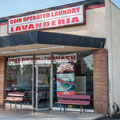
“The actual amount of hot water delivered to the washers was only a small fraction of what the boiler generated and the storage tank also suffered from serious heat loss,” says Nunez, who was inclined to rip out the old setup almost as soon as he laid eyes on it. But his real estate agent advised against the move. Replacing the boiler and its tank companion would entail a major outlay, “so my Realtor thought I should use them as bargaining chips when it came time to sell the place,” he says.
It was a decision that Nunez says he “immediately and consistently regretted” over the next several months, as he busied himself with the other renovation work. For one, the old boiler ran all-out, all day, every day – whether all 31 washers were operating or none were. “I was constantly cooking 275 gal. of 130°F water, a total waste that drove me nuts.”
But there was another, even bigger problem: Lambert was operating without a “safety net,” that is a backup boiler to take over if the main unit ever went down. Losing his one-and-only heat source for any length of time would have meant closing the laundromat without delay to avoid heavy fines. “The Los Angeles County Department of Public Health doesn’t mess around in that situation,” Nunez says. “You have no choice but to suspend operations immediately.”
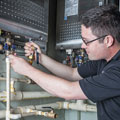
Time for a change
By the time Nunez had completed the other renovation work last spring, he figured enough was enough. The energy-squandering, boiler-tank combo had to go in favor of a new tankless system that would fire only when the washers were actually running, delivering only as much 130°F water as needed.
Nunez was well-acquainted with the benefits of tankless technology, having installed his first unit in the mid-1990s as a young plumber’s apprentice. “I was always open to the idea of tankless because I could see how popular it was outside the United States,” he says. “I felt the technology would change the industry in this country and it certainly has in California. Tankless is commonplace here today.”
Although Nunez has installed his share of tankless units in residential applications over the past decade-and-a-half, a high-demand laundry application was a step up in complexity. So he approached Noritz Southern California District Sales Manager Ryan Simmerman for technical support. Simmerman, in turn, recruited Noritz Project Manager Javier Pacheco and Applications and Technical Service Supervisor Chris Sellers to determine the right mix of water heaters to meet peak demand and provide ample redundancy, all while maximizing efficiency.
After a careful analysis of the floor plan and operation, Sellers specified four Noritz NCC1991-DV-NG gas-fired condensing tankless water heaters, with a thermal efficiency of 94% and maximum gas inputs of 199,900 Btu/hr. If all four tankless water heaters were fully operational, the total input would be 799,600 Btu/hr.
The water heaters are equipped with low-NOx burners with emission levels less than 21 ppm, meeting the new standards of the South Coast Air Quality Management District.
Linked together and to a Noritz SC-301-6M system controller, the quartet operates in stages, continuously adjusting to fluctuating demand. When the first-firing primary unit reaches 50% operational capacity, the second unit kicks in and when the latter reaches 50% capacity, a third unit activates, etc. The role of the primary unit automatically rotates among the four to limit wear-and-tear and prolong service life.
The system controller, which allows all four heaters to be monitored quickly and simultaneously, draws its power from the primary unit. However, if the latter should lose power, another unit will immediately furnish backup power to maintain operations.
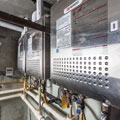
Head-to-head comparison
The unusual circumstance of the licensed installer and the end user being the same person led Noritz to propose a before-and-after test at Lambert. Sellers would use a special meter to calculate the Btu flow rate and total gas usage of the old boiler-storage tank combo for a week. After Nunez and two colleagues installed the new tankless system, Sellers would develop the same metrics for it, on his way to doing a head-to-head comparison.
The comparison test had unavoidable limitations, because there was no control over activity levels at Lambert from one week to the next. As it turned out, the tank-testing period was a busier week than that for the tankless tests, which occurred two weeks later. For example, about 8,600 gal. of hot water were consumed during the tank week; 5,900, during the tankless week.
So Sellers sought to achieve apples-to-apples parity by ignoring activity levels and calculating “how many Btu were needed to produce 1 gal. of 130° F water” by each system. For the tank week, it was 754.1 Btu; for the tankless, 455.4 Btu, a 39.6% savings.
Sellers then extrapolated his measurements over the course of a full year, calculating that the tank system would ultimately use an estimated 3,380 therms, for a yearly gas cost of $2,741.69. The tankless system would consume 2,041 therms, for a total cost of $1,655.56 – again, a savings of nearly 40%. The estimated total cost of the complete tankless system, including all gas and vent piping plus accessories, was $9,838.60. The annual savings in fuel costs of $1,086.13 ($2,741.69 - $1,655.56) yields an estimated payback of nine years.
While that’s a respectable number, Nunez believes the final payback will be considerably shorter.

Challenging installation
The decision to go tankless was the easy part of the Lambert Laundry project. With the support of Sellers and Pacheco, Nunez and his two-man crew had no serious issues installing the four commercial tankless units.
But extricating the old boiler and the storage tank, which measured 9 ft. high and 6 ft. in diameter, from Lambert Laundry’s 12-ft. by 6-ft. mechanical room presented a formidable challenge. The storage tank was so big, Nunez says, that the walls of the mechanical room had to be built around it after the equipment was already in place.
“Our plan going in was simply to demolish the old system and install the new, tankless units in its place,” he explains. “But as soon as we saw the space and the setup, we realized the situation was more complicated and had to be done in phases.”
Step 1 was to erect a temporary installation in another part of the building, consisting of two tankless units and a controller, so the facility could continue to operate as the installation proceeded. Step 2, the toughest part, involved dismantling the old system one chunk at a time. Nunez and colleagues Sonny Gomez and Bill Spartly needed two days to cut the units into pieces with acetylene torches. “We went through two large bottles of oxygen acetylene, but piecemeal was the only way to fit the old equipment through the door and out the building,” Nunez adds.
Steps 3 and 4 entailed assembling the four tankless water heaters and the controller in their proper positions. The third and fourth units were first installed in the mechanical room. The first and second units were then relocated from their temporary spot into the mechanical room.
Nunez followed the recommendation to use condensing units for their higher thermal efficiency. It allowed him to vent with 3-in. Schedule 40 PVC pipe instead of stainless steel. The exhaust run through the roof is approximately 12 ft., while makeup air is fed to the system through a sidewall with a 12-ft. PVC run. The hot- and cold-water lines were two-inch CPVC from Charlotte Pipe, while BrassCraft stainless-steel hoses were used to connect the system to the Dexter Laundry washers. A Grundfos recirculating pump with an aquastat also is installed.
“We hung the four tankless units and the controller high on the wall near the ceiling, leaving plenty of room for storage of cleaning equipment and supplies underneath,” says Nunez, emphasizing another critical advantage in going tankless is space savings.
When the boiler and storage tank dominated the mechanical room, Lambert Laundry had to store supplies in a remote location across town. “That was a bummer,” Nunez continues, “because I was always finding myself missing something. Now I keep all those materials on premises.”
Nunez has even closed one of his plumbing company’s offices and relocated administrative operations to a remodeled section of the mechanical room. In short, the space savings with tankless help lower Nunez’s operating costs in both businesses, while “making our professional lives a little easier.”
Nunez notes the installation took longer due to work being confined to evenings, weekends and lulls between activity at the plumbing company. However, the laundromat never shut down during the retrofit.
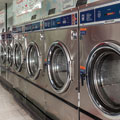
Utility bill savings
None of the installation challenges has left Nunez doubting the wisdom of his decision to buck the real estate agent’s friendly counsel – certainly not after getting his gas bill in June, the first full month post-installation. That initial invoice was about $450, or half what it was a year ago with the boiler-storage tank combo.
The 31 commercial washers at Lambert Laundry have a combined capacity of 1,100 gal. Full operation means each would “turn” three times daily for a potential maximum load of 3,300 gal. of hot water each day.
Lambert can occasionally approach that level of activity during the eight “winter” months (September to April) when the weather is somewhat cooler, the kids are in school full-time and there are more clothes to wash. But in summer, business is slower. “One customer does 50 pairs of school uniform pants weekly during the winter; but come summer, her wash load is cut in half,” Nunez says.
Fewer loads means less hot water needs to be generated, and the longer the tankless units sit idle, the greater the savings over the old boiler system that fired constantly. That is why Nunez expects the 50% cut in his first month’s gas bill to hold for the four warm-weather months. The monthly savings will likely drop to about 35% the rest of the year.
Even so, that calculates to a total annual savings of between $4,000 and $5,000. These are rough estimates, Nunez admits, and only time will tell for certain. But he expects his annual savings will be significantly greater and his payback faster than what the head-to-head test figures indicated.
“The savings generated by those four tankless water heaters have been pretty amazing,” he says. “Their efficiency is helping me turn a nice profit, while easing the pricing pressures of the plumbing business and allowing me to hold my margins. Plumbing is so competitive. A lot of people are taking jobs for 5% profit just to make a decent day’s wages. But thanks to this business, I don’t need to give in.”
In fact, Nunez is thinking of expanding his involvement in the laundromat business – “turning ugly ducklings into golden gooses” - to further extend his business holdings. He has even fielded a serious outside offer to buy Lambert Laundry, he says. Not that Nunez plans to say “yes,” but the new tankless system is one of the major selling points for this would-be buyer.
“In retrospect, replacing the old boiler with tankless should have been one of the first renovations I did, rather than the last,” he comments. “Today, even my Realtor can see it was a very good idea.”

